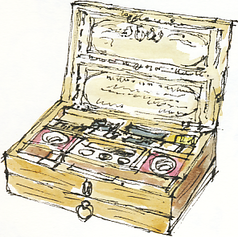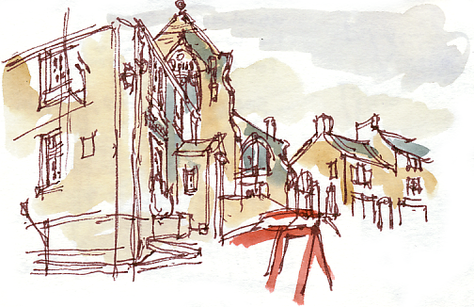previous | home page | this month | e-
Charlotte’s Paint-Box
Richard Bell’s Wild West Yorkshire nature diary, Friday, 24th April 2009
previous | home page | this month| e-

IN THE CURRENT exhibition at The Parsonage at Howarth you can see Charlotte Brontë’s
(1816-
 Some of the cakes of colour, such as the yellow and the white, appear to have been
little used as the decorative stamp of a crown and Prince of Wales’ feathers is still
clear, others look well worn.
Some of the cakes of colour, such as the yellow and the white, appear to have been
little used as the decorative stamp of a crown and Prince of Wales’ feathers is still
clear, others look well worn.
![]() Tucked away at the front of the box is a stub of a brush with what appears to be
a goose quill ferrule. Perhaps this little brush was used for mixing colours rather
than painting.
Tucked away at the front of the box is a stub of a brush with what appears to be
a goose quill ferrule. Perhaps this little brush was used for mixing colours rather
than painting.
I feel that Charlotte was as talented as her brother Branwell (1817-
It’s often suggested that Branwell didn’t make as much headway as he might have as a professional painter because of the time he spent in the Black Bull (right) just across the churchyard from the Parsonage.

George Blackman, Colour Man
Charlotte’s watercolours were manufactured by G Blackman Superfine Colour Preparer. At either side of the impressive coat of arms engraved on the label are the phrases:
‘Warehouses supplied at Lowest Terms . . . For Ready Money only’!
An endorsement from Samuel Moore, secretary of the Society of Arts, Adelphi, praises Blackman’s ‘Improvement in Superfine Colour in Cakes’, awarding him a ‘Large Silver Pallet’ and 20 guineas (£21).
The colours in the original set: Light Red, Green Bice, Lake, Van Brown, Chrome Yellow, Prussian Blue, Vermillion, Sap Green, Verdifer, Yellow Ochre, Burnt Umber and Flake White.
Green Bice was made from smalt, a basic copper carbonate. Lake was a dark red or
crimson, probably still made at this time from lac, a resinous protective coating
secreted on trees by the females a south-
George Blackman (c.1759-
Links
British Artists’ Suppliers, 1650 -